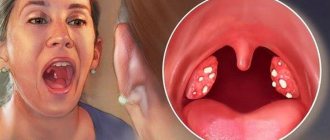06.08.2021
If we talk about the most common reasons for visiting an otolaryngologist, diseases of the throat and larynx are, perhaps, only superior to a runny nose. In most cases, patients struggle with unpleasant symptoms on their own, which often leads to complications and chronic forms of pathologies.
There are many causes of throat and larynx diseases. The lion's share of them are the consequences of the activity of bacteria and viruses, which have similar symptoms to fungal and tumor diseases. There are throat diseases without elevated body temperature; their appearance is provoked by allergens, dry air and substances that irritate the mucous membrane.
Signs and causes
Most diseases of the throat and larynx are infectious in nature. The causative agents are bacteria, viruses and fungi.
The most common bacterial
throat disease - sore throat. Its appearance is caused by streptococci, chlamydia, mycoplasmas, gonococci and tubercle bacilli. Scarlet fever, diphtheria and epiglottitis are also caused by bacteria. All three diseases are manifested by a sore throat, and epiglottitis is generally life-threatening as it can lead to airway obstruction.
Symptoms of bacterial diseases:
- general weakness;
- swelling of the larynx, tonsils;
- high body temperature;
- pain and discomfort in the throat.
For viral
diseases, a sore throat can be one of the symptoms of an illness, for example, ARVI, influenza or measles. Infectious mononucleosis caused by the Epstein-Barr virus (herpes type IV) stands apart. Its development is dangerous due to the rapid spread of inflammation to the spleen and liver, which in turn leads to enlargement of the lymph nodes.
Viral diseases are similar in symptoms:
- heat;
- prostration;
- headache;
- general weakness;
- runny nose;
- cough;
- rash;
- pain and sore throat.
Fungal diseases
genesis - a consequence of the active activity of yeast-like fungi, which looks like a cheesy mass on the mucous membrane during tonsillitis or pharyngitis. Symptoms of a fungal infection of the throat:
- severe sore throat;
- the temperature remains normal.
Fungi quickly multiply in the body during disorders of the gastrointestinal tract, against the background of vitamin deficiency, abuse of antibiotics and hormonal drugs.
A special place as a cause of pain in the throat and larynx is occupied by tumors. It can be primary, that is, formed for the first time, or it can be secondary, the result of metastasis of oncological processes in other parts and organs of the body. The larger the tumor, the more discomfort it brings: the voice changes, becoming hoarse, a feeling of a lump appears in the throat, and it becomes difficult to swallow.
What to do?
Of course, says the ENT doctor, every person can look into his own throat with the help of an ordinary flashlight and mirror. However, you should not turn into your own doctor, warns Vladimir Zaitsev. “Because, for example, the use of antibiotics where it is not required, but antiseptics are needed, can seriously harm. For the same pharyngomycosis, the use of antibiotics will further suppress the flora and allow more active growth of fungi. It is also dangerous not to use antibiotics where they are required. And only a doctor can determine exactly what exactly, in what situation and what courses will be required,” says Vladimir Zaitsev. This means that if you experience a sore throat, an in-person examination and the prescription of adequate therapy are required.
There are contraindications. Be sure to consult your doctor.
Treatment of diseases of the throat and larynx
For any form of the disease, frequent and abundant drinking and rinsing is recommended; this allows you to “wash away” the waste products of viruses and bacteria, relieve inflammation and maintain the mucous membrane in the desired shape (it tends to dry out due to high body temperature during illness).
Most cases respond well to drug treatment if it is started on time. Surgical intervention is sought when purulent or tumor processes begin, that is, the disease takes on a severe form, threatening the patient’s life with suffocation.
What and how to treat:
- ARVI is the most common throat disease. It is characterized by dry throat, sore throat, runny nose, sneezing and coughing. The temperature usually stays between 37–38 degrees. Treated with antiviral drugs based on existing symptoms. Gargling with infusions of chamomile, sage and herbal lozenges helps with sore throat; they relieve irritation and make the treatment pleasantly tasty. Along with this, it is recommended to take vitamin C to support and strengthen the immune system, as well as plenty of warm drinks (herbal teas with honey are welcome);
- tonsillitis is an infectious-allergic disease that mainly affects the tonsils. It is characterized by high body temperature, up to 40 degrees, and unbearable pain in the throat. The larynx and tonsils are red - a sure sign of an inflammatory process - and have a white coating. High fever is accompanied by aching joints and headache. Treatment is prescribed by a doctor, since it is important to prevent complications. Drinking plenty of fluids, gargling with antiseptic herbs, and herbal lozenges help with a sore throat. Food should be taken pureed and liquid, not hot, so as not to injure damaged areas of the mucous membrane;
- pharyngitis is an acute inflammatory process in the pharynx, with a characteristic dry cough, soreness, stabbing pain, a feeling of a lump and inflammation in the mucous membrane, developing into purulent processes. During illness, all solid, spicy, sour and hot foods are excluded from the patient’s diet. Treatment is medicinal, the doctor prescribes antiseptics, since the disease is inflammatory in nature. Self-medication in this case is strictly prohibited: the disease develops quickly and becomes chronic;
- laryngitis - inflammation of the vocal cords and larynx is characterized by a barking cough with sputum, a hoarse voice until its complete disappearance, and a scratching pain in the throat. Children often suffer from laryngitis. Laryngitis causes swelling of the throat when lying down, which can lead to suffocation. Therefore, if you find that your child begins to choke while lying in bed, call an ambulance, lift the child to an upright position and take him to the bathroom, under a warm shower, to relieve the spasm. Laryngitis is treated with inhalations, warm compresses, warm drinks and silence. To alleviate the patient's condition, high humidity is needed in the room: a container of water, a diffuser or a wet towel on a radiator;
- Tonsillitis is an inflammation of the tonsils, which is characterized by high body temperature, acute sore throat, and bad breath due to purulent plaque on the tonsils. The main causes of tonsillitis are viruses and bacteria. The course of treatment includes gargling with a solution of soda and salt - it acts as an antiseptic and “washes away” the pus.
Bacterial throat diseases develop very quickly, within a few hours. Viral ones - a little slower. But only a doctor can determine the real etiology of the disease, and then only based on test results.
Relieving throat muscle tension during neurosis
Tension of the throat muscles during neurosis causes breathing problems. In the complex treatment of neurosis of the pharynx and larynx, breathing exercises can give good results. It helps relieve spasm and tension in the respiratory muscles, restore breathing rhythm, reduce the dosage of medications, and speed up the healing process. You need to take an active short breath and a natural passive exhalation. The air should be inhaled through the nose, making a short, strong movement, and exhaled through the mouth.
The breathing movement and inhalation must coincide in time. The rhythm of breathing movements should correspond to the rhythm of the march. Breathing exercises for throat neurosis can be done standing, sitting or lying down. Their effectiveness improves in fresh air. To determine the cause and type of throat neurosis, exclude the organic nature of the disease and undergo a course of effective therapy, call the contact center of the Yusupov Hospital.
Prevention
It is impossible to ensure that your throat never hurts, especially in the autumn-winter period. But prevention can be carried out regularly to reduce the risk of illness and strengthen the immune system. For this:
- stop smoking if you smoke - nicotine irritates and dries out the mucous membrane of the nose and throat, making them vulnerable to pathogens;
- eat a varied and nutritious diet so that the body receives vitamins and minerals in full;
- humidify the indoor air - artificial indoor fountains, aquariums, diffusers, and water containers are suitable for this. Too dry air is a strong irritant to the throat and contributes to the appearance of microtraumas on the mucous membrane;
- wash your hands more often - pathogenic bacteria, as a rule, enter our body from dirty hands;
- take vitamins - they support the immune system;
- dress according to the weather - during hypothermia, blood vessels narrow, which destroys the protective mechanism of the mucous membrane and the person catches a cold. The cold itself does not contribute to this;
- do not self-medicate - there is a high risk of complications, for example, in the form of hearing loss or disease of the ears, lungs, eyes or brain.
If you feel unwell, consult a doctor. You can make an appointment with a multidisciplinary medical otolaryngologist using the feedback form or by calling.
Diagnosis of throat neurosis at the Yusupov Hospital
In order to establish the cause of throat neurosis, doctors at the Yusupov Hospital conduct a comprehensive examination of the patient. Using radiography of the cervical spine, osteochondrosis is detected or excluded. More accurate information is obtained after a computed tomography scan of the spine. Patients undergo laboratory tests (general and biochemical blood tests, thyroid hormone levels).
In order to exclude the organic nature of the disease, doctors perform magnetic resonance and computed tomography of the throat. A comprehensive examination includes Doppler ultrasound of the vessels of the brain and neck, and electromyographic study. Patients are consulted by an otolaryngologist, neurologist, vertebrologist, and psychotherapist.
Anatomy of the throat
In the pharynx and larynx, as well as at the border of the oral and nasal cavities along the back wall of the pharynx, there are accumulations of lymphoid tissue - the lymphoid-pharyngeal ring. It performs a protective function and is an important organ of our immunity. The largest collections of lymphoid tissue are called tonsils and there are several of them: two palatine, two tubal, one pharyngeal (aka adenoid) and one lingual.
Below is the larynx - this is a complex organ, representing a complex of various tissue structures, consisting of several cartilages, muscles, with a developed network of blood, lymphatic vessels and nerves.
Tonsillitis and its features
Tonsillitis is also a common type of throat disease. The acute form of this pathology is more often called tonsillitis, and the chronic course is characterized by sluggish inflammation of the tonsils. The cause of such a throat disease as tonsillitis is most often bacteria (staphylococcus), and the frequency of exacerbations and the intensity of inflammation depends solely on the resistance of the immune system.
The development of tonsillitis can be caused by diseases such as scarlet fever (red tonsils, crimson tongue, rash on the body with a small dot), mononucleosis (tonsils, liver, spleen are significantly enlarged, monocytes are increased in the blood test), enterovirus infection (dyspeptic disorders, fever body).
Examination, the appearance of the sore throat and the patient’s complaints are usually sufficient symptoms to make a diagnosis. If necessary, the issue of taking a smear from the throat mucosa for bacteriological examination is decided.
What does the doctor think?
“In patients with chronic tonsillitis, tonsillitis occurs 10 times more often than in practically healthy people.”
How is the feeling of a lump in the throat treated?
Treatment is determined by the causes and mechanism of development of the disease and is selected individually for each patient.
For a recent and non-severe condition
treatment is carried out on an outpatient basis: the doctor conducts a psychotherapeutic session, prescribes medications that the patient takes at home and periodically comes for follow-up consultations.
For moderate severity
- treatment in a day hospital is recommended: daily treatment procedures are carried out (drug infusions, physiotherapy, etc.), which take an hour and a half, but the patient lives at home and goes about his usual business. The average course of a day hospital is about 10 days.
In severe condition
hospitalization in a hospital is recommended. Due to intensive treatment, the condition can be stabilized already in the first hours of stay. The average length of hospital stay is 10 days (from 5 to 30 days depending on the severity of the condition and the body’s recovery abilities).
Main methods of treatment:
- Psychotherapy.
- Drug treatment (pharmacotherapy).
- Physiotherapy.
- Massage and manual therapy.
- Diet therapy.
- Biofeedback therapy.










